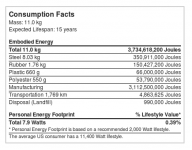Did you know that we should take into account the embodied energy when we compare the consequences of our energy use and transportation? WattzOn provides tools for us to track our energy consumption and compare it to a recommended 2000 Watt lifestyle (as a sustainable lifestyle). Eightlines on Twitter alerts us to the embodied energy of bicycles and e-bikes, which are both much lower than a typical energy efficient car such as the Toyota Prius. (The embodied energy is the energy it takes to create the object, which is then divided over the lifetime of the object.)
It comes as no surprise that a steel frame bicycle has a very low embodied energy at about 7.9 Watts (these numbers are necessarily ball-park). The bike only makes up a tiny fraction of the "2000 Watt lifestyle".

The car is another matter. This calculation was based on the Toyota Prius, one of the more energy efficient cars on the road. The embodied energy makes up 13.5% of the recommended energy use.
[img_assist|nid=3372|title=|desc=|link=node|align=center|width=500|height=409]
Last, the e-bike comes in at 2% of the recommended lifestyle. While the embodied energy is is an order of magnitude larger than the steel bicycle, it is still much smaller than the car. So if you choose an e-bike you might not come off as clean-looking as the bicycle rider, you can still save your guilt for something else (such as newspapers which happen to have a huge embodied energy component - twice that of cars!). E-bikes not only require much less energy to manufacture they require much less road and parking as well as less energy to move.
[img_assist|nid=3373|title=|desc=|link=node|align=center|width=463|height=450]
You may ask why watts? This is their explanation: in order to reduce our carbon footprint, we will have to take into account energy reduction.
A watt is a unit of power that indicates the rate at which you are using energy. For WattzOn, we normalize all of your profile answers (say, flights per year or miles driven per week) down to the second, so that you can see the average power that you are using in every moment of your life.
We chose watts because we want to change the conversation on personal accountability in climate change away from the common "carbon footprint" and towards collective energy reduction. Measuring in power rather than carbon emissions recognizes that it will not be possible to support our current lifestyles with any energy technology that we could implement in the near future - our needs are not sustainable. While there certainly needs to be a reduction of fossil fuel reliance by increasing alternative energy infrastructure, energy reduction will need to be part of any solution to this global challenge.

